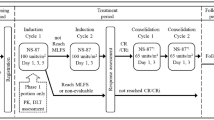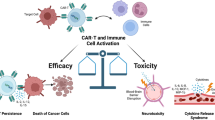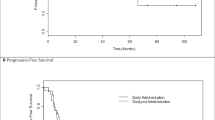Abstract
Objective
To study the efficacy and safety of Shuanghuang Shengbai Granule (双黄升白颗粒, SSG), a traditional Chinese herbal medicine, on myelosuppression of cancer patients caused by chemotherapy.
Methods
A total of 330 patients were randomly assigned to the treatment group (220 cases, analysed 209 cases) and the control group (110 cases, analysed 102 cases) with a 2:1 ratio by envelope method. The patients in the treatment group at the first day of chemotherapy started to take SSG for 14 days, while the patients in the control group took Leucogon Tablets. The changes of the blood routine, clinical symptoms and immune function in both groups were observed for safety and efficacy evaluation.
Results
At the 7th day of chemotherapy, the white blood cells (WBCs) level in the treatment group was significantly higher than that in the control group (P<0.05). After treatment, the WBCs rate in the normal range accounted for 50.2% in the treatment group, the myelosuppression of WBCs and neutrophil were mainly grade I, while 8.1% and 5.7% of patients emerged grade III and grade IV myelosuppression, respectively. The incidence of myelosuppression of the treatment group was significantly lower than that of the control group (P<0.05). The total effective rate of Chinese medicine syndrome in the treatment group was significantly higher than that in the control group (84.2% vs. 72.5%, P<0.05). The immune cell levels in both groups were maintained in the normal range. Compared with that before treatment, the levels of CD3+ and CD4+ cells were significantly increased in the treatment group after treatment (P<0.05). The discrepancy of CD3+ and CD4+ cell activity before and after treatment in both groups were significantly different (P<0.05). No obvious adverse event occurred in both groups.
Conclusion
SSG had a protection effect on bone marrow suppression, and alleviated the clinical symptoms together with clinical safety.
Similar content being viewed by others
References
Parkin DM, Bray F, Ferlay J. Global cancer statistics. CA Cancer J Clin 2002 2005;55:74–108.
Yang L, Parkin DM, Ferlay J. Estimates of cancer incidence in China for 2000 and projections for 2005. Cancer Epidemiol Biomarkers Pre 2005;14:243–250.
Liao ZJ, Nan KJ, Han J, eds. Modern treatment of tumor pharmacology. Xi'an: World Book Publishing Inc; 2002:23–190.
Li DA, Wang DZ, Zhang SY. Drug epidemiological study on antitumor drugs and chemotherapy in patients with bone marrow inhibition. Chin J Pharm (Chin) 2010;45:1968–1970.
Shen YH, Chen CX, Xu ZH. Effect of Shuanghuang Shengbai Granule on hematopoietic cell function in leukopenia disease research mice model. Chin J Pharm (Chin) 2006;31:754–759.
Wang LF, Xu ZH, Jing CJ. Dual regulation mechanism and effect of Shuanghuang Shengbai Granule on cell cycle inhibition of chemotherapy-induced bone marrow cells in Lewis lung carcinoma bearing mice. Chin J Integr Tradit Chin West Med (Chin) 2009;7:453–457.
Wang LF, Xu ZH, Jing CJ. Dual regulation mechanism of Shuanghuang Shengbai Granule on cell cycle of Lewis lung cancer mice. Shanghai J Tradit Chin Med (Chin) 2009;43:56–59.
Gridelli C, Perrone F, Monfardini S. Lung cancer in the elderly. Eur J Cancer 1997;33:2313–2314.
Chinese Anti-Cancer Association. New criteria of diagnosis and treatment for common malignant tumor. Beijing: Peking Union Medical College Press; 1997:737–781.
Zhou CC, Wang LH, Zhou DA, eds. Oncology. Shanghai: Tongji University Press; 2001:136–137.
Zheng XY, ed. Clinical research guidance for new traditional Chinese medicine. Beijing: Chinese Medical Science and Technology Press; 2002:219.
Cai XY. Research progress in mechanisms of the Kidney therapy for bone marrow suppression. Shanghai J Tradit Chin Med (Chin) 2007;41:75–77.
Chu ZZ, Chen XY, Li H. Clinical discussion on theory and control strategy of Chinese bone marrow suppression after chemotherapy. Chin J Tradit Chin Med (Chin) 2005;20:676–678.
Author information
Authors and Affiliations
Corresponding author
Additional information
Supported by National Natural Science Foundation of China (No. 81202670), and Project of Longhua Medical Team Shanghai, China (No. LYTD-18)
Rights and permissions
About this article
Cite this article
Wang, Lf., Xu, Zy., Wang, Zq. et al. Clinical observation of Shuanghuang Shengbai Granule (双黄升白颗粒) on prevention and treatment of myelosuppression caused by chemotherapy in cancer patients. Chin. J. Integr. Med. 23, 105–109 (2017). https://doi.org/10.1007/s11655-016-2503-4
Received:
Published:
Issue Date:
DOI: https://doi.org/10.1007/s11655-016-2503-4




